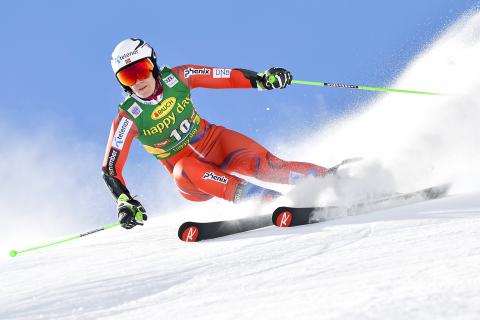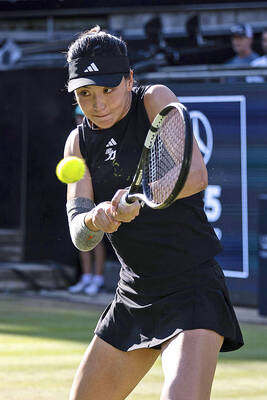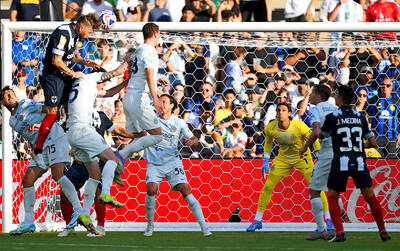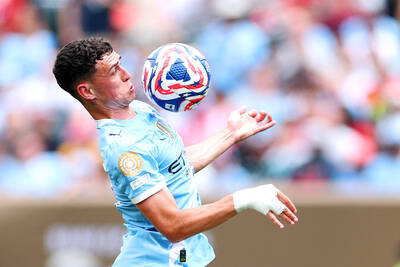Having tested new giant slalom (GS) skis over the summer, Kjetil Jansrud can hardly wait for the start of the World Cup season today.
The equipment has given the Norwegian back his joy for a discipline he used to be really good at.
“I am now having fun again skiing GS. It feels like driving a Formula One car,” Jansrud said.

Photo: EPA
GS became a torture to Jansrud when rules for the size and shape of the skis changed five years ago.
Once he was a leading competitor in the discipline. Jansrud won Olympic silver in 2010 and had 16 World Cup top 10 results including six podiums in 51 races.
However, he never got used to the altered hourglass shape of the skis introduced prior to the 2012 to 2013 season. Since then, Jansrud has finished in the top 10 just once in 31 races.
Those skis were longer and narrower than the old ones. They had a 35m instead of 28m radius, meaning they made it much harder to make the turns between the gates as they required more strength and a specific technique.
Leading skiers like Bode Miller, Ted Ligety and Aksel Lund Svindal were firm opponents of the new skis, but governing body the International Ski Federation (FIS) cited years of scientific research into injury prevention to justify their introduction.
However, as an increasing number of GS racers started suffering from back problems, FIS was forced into action again.
With another rule change taking effect this season, the radius has been reduced again to 30m, making the skis look quite similar to the old model from before 2012.
“It was a common decision from top racers, the industry and FIS,” men’s race director Markus Waldner said. “Many speed guys, also some slalom specialists, moved away from GS, but our core discipline should always be the GS. In the past, with Stephan Eberharter and Hermann Maier, speed guys were performing super well in GS. This is what we want to achieve in the future again.”
Waldner, who was not yet in charge in 2012, said the scientific research that backed the previous rule change was “not significant enough.”
“It is difficult to come up with really clear, transparent figures and data,” he said. “We are researching especially the highest level, the World Cup. But we don’t have much data on injuries on lower levels, but these would give you a clear picture.”
With the new skis, giant slalom will become more appealing again for Jansrud and other speed specialists, who have lost interest in the discipline in the past five seasons.
“I think it’s maybe easier to go from downhill to giant slalom. So in some weeks, when we have downhills and then go to GS the next week, that is going to be an easier transition,” Jansrud said.
As more downhill and super-G skiers were expected to gain points in GS again, the equipment change could also affect the competition for the overall World Cup title.
Marcel Hirscher has taken that title in each of the past six seasons as the Austrian dominated the slalom and GS events.
“Of course it can change something, but it is really difficult to say right now, how much and for whom,” French all-event skier Alexis Pinturault said. “For a down-hiller it is going to be complicated, anyway. Because now they are back in the rankings so the bib numbers are quite high for them. So it’s going to be really difficult.”
Jansrud, who finished runner-up to Hirscher in 2015 and again last season, also was not expecting a major overhaul of the rankings.
“The best guy will be going to be the best, anyway,” he said. “I think you are going to see the same faces.”

Twelve days after winning her second Grand Slam title at the French Open, Coco Gauff fell at the first hurdle on grass in Berlin on Thursday as beaten Paris finalist Aryna Sabalenka advanced to the quarter-finals. Recipient of a first round bye, American Gauff lost 6-3, 6-3 to Chinese qualifier Wang Xinyu as world number one Sabalenka beat Rebeka Masarova 6-2, 7-6 (8/6) in her second round tie. Winner of 10 main tour titles, including the US Open in 2023 and the WTA Finals last year, Gauff has yet to lift a trophy in a grass-court tournament. “After I won the first

Aaron Civale got a little wild in the right-hander’s first start for the Chicago White Sox two days after he was traded by the Milwaukee Brewers. Civale on Sunday walked four of the first seven hitters he faced in a 2-1 loss to the Texas Rangers. The 30-year-old finished with four walks, one off his career high, while allowing six hits and two runs in five innings. He threw 65 strikes and 39 balls. Chicago trailed 2-1 when he was replaced by Dan Altavilla to start the sixth. “Not the cleanest,” Civale said. “It’s been a whirlwind of a week. First couple

Sergio Ramos on Tuesday outfoxed two Inter players and artfully headed home the first goal for Monterrey at the FIFA Club World Cup. The 39-year-old Ramos slipped through the penalty area for the score just as he did for so many years in the shirts of Real Madrid and Spain’s national team, with whom he combined smarts, timing and physicality. Ramos’ clever goal and his overall defensive play at the Rose Bowl were major factors in Monterrey’s impressive 1-1 draw against the UEFA Champions League finalists in the clubs’ first match of the tournament. “There is always a joy to contribute to the

DOMINANT JUVENTUS: Randal Kolo Muani and Francisco Conceicao both scored braces as Juventus made a statement in their opener with a big win over Al-Ain Phil Foden on Wednesday scored two minutes into the match and later had an assist to lead Premier League powerhouse Manchester City past Moroccan club Wydad AC 2-0 at the FIFA Club World Cup. City broke Wydad’s five-man defensive line early when Foden scored on a deflected cross by goalkeeper El Mehdi Benabid. Jeremy Doku doubled City’s lead in the 42nd minute off a corner-kick from Foden. Shortly afterward, an animal-rights advocate ran onto the field to protest Morocco’s treatment of stray dogs and cats. The man was tackled by security workers and escorted out of Lincoln Financial Field, which was just over